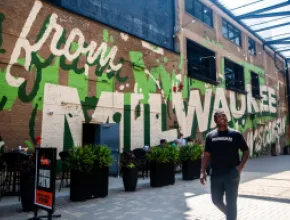When the 20th-century Canadian philosopher Marshall McLuhan coined the phrase “the medium is the message,” he probably couldn’t have imagined that within a few short decades an array of social media (not to mention a veritable army of tiny electronic devices) would blast onto the scene, providing seemingly endless ways to communicate. Savvy meeting and event planners, meanwhile, have scrambled to leverage these new options in ever-changing ways.
“Social media is now integral to all conferences and events I do—especially those for the public,” said Lizzy Caston, president of Portland, Ore.-based Caston Communications, a company that specializes in content planning and project management. “We use it for marketing, sales [and] to gain sponsors, as well as for overall community building.”
“My favorite thing about social media is the instant response that it provides,” said Stuart Ruff-Lyon, vice president of events and education at RIMS, the Risk Management Society, in New York. “I love monitoring our hashtag and seeing what we’re doing that excites them.”
Indeed, social media—when used effectively—can help planners achieve a variety of goals.
Expanding an event beyond its physical space is a goal for Roni Weiss, the organizer of the New York Travel Festival, which attracts about 800 participants for a multiday tourism conference in New York every year.
“We’re a smaller event compared to The New York Times Travel Show, so the way we make up for that is that we’re not just about the physical attendees,” he explained. “We have a community that we work with throughout the year. We have global reach.”
Weiss stresses quality over quantity when it comes to social media engagement.
“It’s not just the number of people that engage but who engages,” he said. “If you look at the numbers, there are plenty of accounts that have more numbers than we do, but we have influential people in the media and across the landscape.”
Helpful Partnerships
Outside vendors, consultants and host venues can be valuable resources for planners looking to develop a social media strategy, according to Geoff Lawson, vice president and general manager at the National Conference Center in Leesburg, Va.
“The National Conference Center often helps clients with their social media initiatives for their meetings at the property,” he said. “One in particular, NS2 Serves, which is a workforce-training program for ex-military, asked us to help get the word out about their training program that was taking place at The National last spring. We put together a social media fact sheet for the client, with sample tweets that we would use on Twitter, and how we would promote their event on our Facebook and LinkedIn.”
The National now offers social media help as part of its sales contract.
Qualified outside assistance is also crucial for Mindy L. Bomonti, a Seattle-based experiential marketing and events specialist who organizes the Microsoft presence at tradeshows and conferences. To keep the social media strategy intact once her events kick off, she has hired social media management consultants to oversee day-to-day engagement through various channels, and brought them on-site to post live from the show floor.
“With this, I am able to better manage the specific messages that we can plan [and] time for release, and they can provide the real-time engagement with posts and responses that drive followers to come to our booth for additional information and discussion,” she said.
PageBreak
Getting Attendees on Board
Needless to say, some people are more into social media than others. So how do you get maximum results with less-engaged attendees? A few suggestions: Make it fun, make it beneficial, and provide pain-free training.
Ruff-Lyon said he incorporates shareable “fun elements” into his social media strategy, such as for its 2016 annual conference in San Diego.
“We had these gigantic wooden letters built—our logo—so that people could take a photo and become the ‘I’ of RIMS,” he said. “That was wildly successful for us. It was probably a 200 percent social media increase.”
To bring less-experienced attendees up to speed, Ruff-Lyon arranged for on-site coaching that also helped attendees sharpen their own career development skills.
“We provided on-the-spot social media training to teach them Twitter, LinkedIn, things like that,” he said. “We also have a ‘thought leader theater,’ and we started adding social media training into that.”
Building excitement across multiple platforms is key for the success of events organized by Alex Beaton, engagement and marketing manager at OfficeNinjas, a company that educates administrative personnel.
“We post regularly about our upcoming events on Facebook, Twitter, Instagram and in our LinkedIn group,” he said, noting that this tactic was especially successful during a recent event at Chaminade Resort & Spa in Santa Cruz, Calif. “We also use Pinterest to gather event inspiration and document our previous events. We love seeing our community comment about their excitement, as that offers social proof to prospective attendees.”
Making event-specific social media content accessible for non-attendees is a goal for Mark Cooper, CEO of IACC.
“We incorporate a ‘social wall’ into the event, where event tweets and posts are shown on a large video wall during the conference,” he said, noting that the online “wall” showcases delegate posts and photos during and after the conference. “It’s a great way for those who do not attend to get a feel for the buzz created at events and the personal connections.”
Revenue streams should also be explored, according to Michael Quonce, public relations and advertising director at Hotel Roanoke and Conference Center in Roanoke, Va.
“Social media can certainly enhance the event experience and should be a part of the contract discussions as an add-on value and service well in advance, with specific campaigns, ideas and goals,” he said.
Choosing the Right Tool
Social media strategies vary widely.
“Each platform is like a tool with different functions,” Caston said. “You wouldn’t use a spoon for the work of a knife. And it depends on the event and the market for that event. For example, a business-focused event may not be appropriate for Pinterest, but a food event might be. Facebook is just kind of a catchall. It’s also—unless you are super-established, like the [Specialty Food Association’s] Fancy Food Show—difficult to get good traction on, unless you want to pay for ad buys and sponsored posts.”
Quonce concurred that different platforms have different strengths.
“While each channel has their own usage and specific reach and target audiences, Facebook has been the most successful in terms of attracting and booking events,” he said. “Twitter is great for anticipation of events, sharing event details, engaging when on property and post discussions; Instagram has been great for showcasing event details, sharing hashtags and visually enhancing the event; Youtube and video is starting to work to very visually excite groups in pre-arrival and event promotion.”
But even those who benefit from social media may still see its limitations.
“Personally, I have a slightly pessimistic view of social media and its future at events,” Bomonti said. “I think we have reached its saturation point. That’s not to say that new tech won’t come along and we’ll have a new ‘it’ tool or engagement booster of the moment. But at my events and conferences, I’m seeing more interest in connecting face-to-face and stepping away from the screens and devices. Social media may lead them to the booth or the topic, but the sale is still made in the meeting room.”






